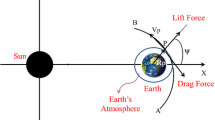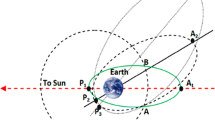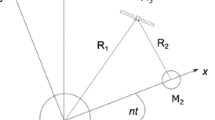Abstract
A maneuver called “Aerogravity Assisted” is known in the literature to increase the energy gains given by a close approach between a spacecraft and a planet using the atmosphere of the planet. Several previous papers showed the importance of this topic in different aspects. The present paper has the goal of studying the effects of the spacecraft rotation in this maneuver. This rotation implies in a variable ballistic coefficient and this fact can change the results of the maneuver. Several masses, sizes and angular velocities will be tested and the effects of these parameters will be measured. The dynamical model considers the atmosphere of the Earth, in terms of drag, the gravitational fields of the Earth and the Sun, assumed to be points of mass, and the rotating spacecraft. The Earth and the Sun are assumed to be in circular coplanar orbits around their common center of mass. The equations of motion are the ones given by the circular planar restricted three-body problem with the addition of the forces generated by the atmospheric drag. The primary objective is to map the energy variations of the spacecraft orbits due to this close approach as a function of the spacecraft angular velocity. This rotation can be used as control of the maneuver to try to reach different goals.
Similar content being viewed by others
References
R.A. Broucke, The celestial mechanics of gravity assist, in AIAA/AAS Astrodynamics Conference (Minneapolis, MN, USA, 1988), Vol. 88
C.E. Kohlhase, P.A. Penzo, Space Sci. Rev. 21, 77 (1977)
M.A. Minovich, A Method for Determining Interplanetary Free-Fall Reconnaissance Trajectories (Pasadena, CA, JPL, 1961), 47p. (JPL Tec. Memo 312-130)
R. Carvell, Space 1, 18 (1985)
D. Dunham, S. Davis, J. Astron. Sci. 33, 275 (1985)
R.L. McNutt Jr, S.C. Solomon, R.E. Gold, J.C. Leary, Adv. Space Res. 38, 564 (2006)
R.L. McNutt Jr, S.C. Solomon, R. Grard, M. Novara, T. Mukai, Adv. Space Res. 33, 2126 (2004)
R. Grard, Adv. Space Res. 38, 563 (2006)
G. Felipe, A.F.B.A. Prado, Adv. Space Res. 34, 2256 (2004)
J.M. Longuski, N.J. Strange, J. Spacecraft Rockets 39, 9 (2002)
A.F.S. Ferreira, A.F.B.A. Prado, O.C. Winter, Adv. Space Res. 56, 252 (2015)
T.T. McConaghy, T.J. Debban, A.E. Petropulos, J.M. Longuski, J. Spacecraft Rockets 40, 380 (2003)
L. Casalino, G. Colasurdo, D. Pasttrone, J. Guidance Control Dyn. 22, 637 (1999)
A.F.B.A. Prado, R.A. Broucke, Acta Astron. 36, 285 (1995)
V.M. Gomes, J. Murcia, A.F.B.A. Prado, J. Golebiewska, Comput. Appl. Math. 37, 1 (2015)
J. Murcia, A.F.B.A. Prado, V.M. Gomes, Rev. Mex. Astron. Astrofis. 54, 485 (2018)
J. Murcia, A.F.B.A. Prado, V.M. Gomes, Rev. Mex. Astron. Astrofis. 54, 143 (2018)
J. Murcia, A.F.B.A. Prado, J. Astron. Sci. 66, 1 (2019)
J. Murcia, A.F.B.A. Prado, Astrophys. Space Sci. 362, 1 (2017)
V. Szebehely, Theory of orbits: the restricted problem of three bodies (Yale University, New Haven CT, 1967)
S. Schaaf, P. Chambre, in Flow of Rarefied Gases (Princeton University, Princeton, NJ, 1961), Vol. 8
A. Tewari, J. Spac. R. AIAA 46, 299 (2009)
J. Picone, A.E. Hedin, D. Pj Drob, A.C. Aikin, J. Geophys. Res.: Space Phys. 107, 116 (2002)
E. Fehlberg, Classical Fifth-, Sixth-, Seventh-, and Eighth-Order Runge–Kutta Formulas with Step Size, NASA Report TRS-287 (NASA, Washington, DC, 1968)
W.W. Vaughan, D.L. Johnson, C.G. Justus, Guide to Reference and Standard Atmosphere Models (AIAA, 2010), AIAA G-003C-2010
R.A. Minzner, K.S.W. Champio, H.L. Pond, The ARDC Model Atmosphere, 1959(United States Air Force, 1959)
ISO, Space system – estimation of orbit lifetime (2016), ISO 27852:2016
Author information
Authors and Affiliations
Corresponding author
Additional information
Publisher’s Note
The EPJ Publishers remain neutral with regard to jurisdictional claims in published maps and institutional affiliations.
Rights and permissions
About this article
Cite this article
Murcia Piñeros, J.O., Gomes, V.M., dos Santos, W.A. et al. Effects of the rotation of a spacecraft in an atmospheric close approach with the Earth. Eur. Phys. J. Spec. Top. 229, 1517–1526 (2020). https://doi.org/10.1140/epjst/e2020-900144-9
Received:
Revised:
Published:
Issue Date:
DOI: https://doi.org/10.1140/epjst/e2020-900144-9




